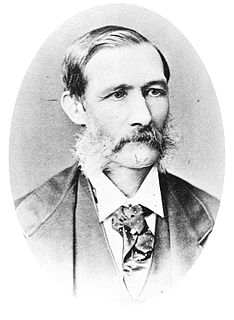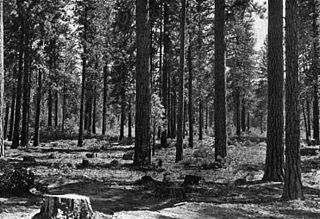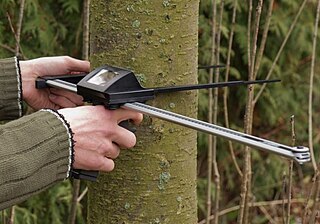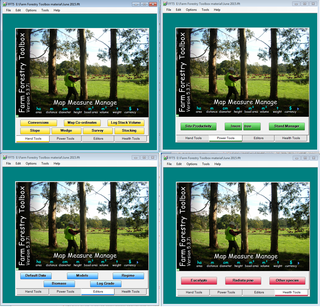Biostatistics are the development and application of statistical methods to a wide range of topics in biology. It encompasses the design of biological experiments, especially in medicine, pharmacy, agriculture and fishery; the collection, summarization, and analysis of data from those experiments; and the interpretation of, and inference from, the results. A major branch is medical biostatistics, which is exclusively concerned with medicine and health.

Sir Dietrich Brandis was a German-British botanist and forestry academic and administrator, who worked with the British Imperial Forestry Service in colonial India for nearly 30 years. He joined the British civil service in Burma in 1856, shortly after became head of the British forestry administration in all of Burma, and served as Inspector General of Forests in India from 1864 to 1883. He returned to Europe in 1883, dividing his time between Bonn and Greater London. In retirement he dedicated himself to scholarly work, resulting in his monumental book Indian Trees (1906). He is considered the father of tropical forestry and has also been described as the father of scientific forestry. In addition to his work in India, he also had a significant influence on forest management in the United States.
This article is the index of forestry topics.

Selection cutting, also known as selective cutting, is the silvicultural practice of harvesting trees in a way that moves a forest stand towards an uneven-aged or all-aged condition, or 'structure'. Using stocking models derived from the study of old growth forests, '"Selection cutting"', also known as 'selection system', or 'selection silviculture', manages the establishment, continued growth and final harvest of multiple age classes of trees within a stand. A closely related approach to forest management is Continuous Cover Forestry (CCF), which makes use of selection systems to achieve a permanently irregular stand structure.

Diameter at breast height, or DBH, is a standard method of expressing the diameter of the trunk or bole of a standing tree. DBH is one of the most common dendrometric measurements.
Forest management is a branch of forestry concerned with overall administrative, economic, legal, and social aspects, as well as scientific and technical aspects, such as silviculture, protection, and forest regulation. This includes management for aesthetics, fish, recreation, urban values, water, wilderness, wildlife, wood products, forest genetic resources, and other forest resource values. Management can be based on conservation, economics, or a mixture of the two. Techniques include timber extraction, planting and replanting of various species, cutting roads and pathways through forests, and preventing fire.
The following outline is provided as an overview of and guide to forestry:

A forest product is any material derived from forestry for direct consumption or commercial use, such as lumber, paper, or forage for livestock. Wood, by far the dominant product of forests, is used for many purposes, such as wood fuel or the finished structural materials used for the construction of buildings, or as a raw material, in the form of wood pulp, that is used in the production of paper. All other non-wood products derived from forest resources, comprising a broad variety of other forest products, are collectively described as non-timber forest products (NTFP). Non-timber forest products are viewed to have fewer negative effects on forest ecosystem when providing income sources for local community.

In forestry, periodic annual increment (PAI) is the change in the size of a tree between the beginning and ending of a growth period, divided by the number of years that was designated as the growing period. For sigmoid growth, the graph of PAI increases rapidly and then quickly declines, approaching zero. PAI may go negative if a tree loses volume due to damage or disease. Periodic annual increment is commonly used instead of current annual increment as a basis for computing growth per cent. Growth per cent indicates the rate of increase with relation to the wood capital required for its production, this is usually based on a single year's growth.
Site index is a term used in forestry to describe the potential for forest trees to grow at a particular location or "site." Site is defined as “The average age of dominate and/or codominate trees of an even-aged, undisturbed site of intolerant trees at a base age”; furthermore, the word site is used in forestry to refer to a distinct area where trees are found. Site index is used to measure the productivity of the site and the management options for that site and reports the height of dominant and co-dominant trees in a stand at a base age such as 25, 50 and 100 years. For example, a red oak with an age of 50 years and a height of 70 feet (21 m) will have a site index of 70. Site index is species specific. Common methods used to determine site index are based on tree height, plant composition and the use of soil maps.

Tree allometry establishes quantitative relations between some key characteristic dimensions of trees and other properties. To the extent these statistical relations, established on the basis of detailed measurements on a small sample of typical trees, hold for other individuals, they permit extrapolations and estimations of a host of dendrometric quantities on the basis of a single measurements.
Forest inventory is the systematic collection of data and forest information for assessment or analysis. An estimate of the value and possible uses of timber is an important part of the broader information required to sustain ecosystems. When taking forest inventory the following are important things to measure and note: species, diameter at breast height (DBH), height, site quality, age, and defects. From the data collected one can calculate the number of trees per acre, the basal area, the volume of trees in an area, and the value of the timber. Inventories can be done for other reasons than just calculating the value. A forest can be cruised to visually assess timber and determine potential fire hazards and the risk of fire. The results of this type of inventory can be used in preventive actions and also awareness. Wildlife surveys can be undertaken in conjunction with timber inventory to determine the number and type of wildlife within a forest. The aim of the statistical forest inventory is to provide comprehensive information about the state and dynamics of forests for strategic and management planning. Merely looking at the forest for assessment is called taxation.

Johann Heinrich Cotta, also Heinrich von Cotta, was a German silviculturist who was a native of Kleine Zillbach, near Wasungen, Thuringia. He was founder of the Royal Saxon Academy of Forestry, in Tharandt, and is known as a pioneer of scientific forestry. He was the father of the geologist Bernhard von Cotta (1808–1879).
Robert Scott Troup CMG CIE FRS was a British forestry expert. He spent the first part of his career in Colonial India, returning to England in 1920 to head Oxford's School of Forestry.
Wayne Arthur Fuller is an American statistician who has specialised in econometrics, survey sampling and time series analysis. He was on the staff of Iowa State University from 1959, becoming a Distinguished Professor in 1983.
Walter Bitterlich was a world-renowned forest scientist. A notable contributions of his to the forestry profession was the invention of the relascope used in forest inventories. The Society of American Foresters (SAF) declared him "the world's most famous Ranger".
Pandurang Vasudeo Sukhatme (1911–1997) was an award-winning Indian statistician. He is known for his pioneering work of applying random sampling methods in agricultural statistics and in biometry, in the 1940s. He was also influential in the establishment of the Indian Agricultural Statistics Research Institute. As a part of his work at the Food and Agriculture Organization in Rome, he developed statistical models for assessing the dimensions of hunger and future food supplies for the world. He also developed methods for measuring the size and nature of the protein gap.

The Farm Forestry Toolbox is a collection of computer programs, referred to as 'Tools', intended to be used by farm forest owners and managers to aid decision making. The Toolbox includes a set of simple 'Hand Tools'; conversion of measurements and map co-ordinates; measuring the volume of stacked logs, slope, basal area; and a survey tool. A second set of more complex tools or 'Power Tools'; can be used to estimate site productivity, volume and value of wood grown for individual trees, at the coupe or stand level and forest estate level.












